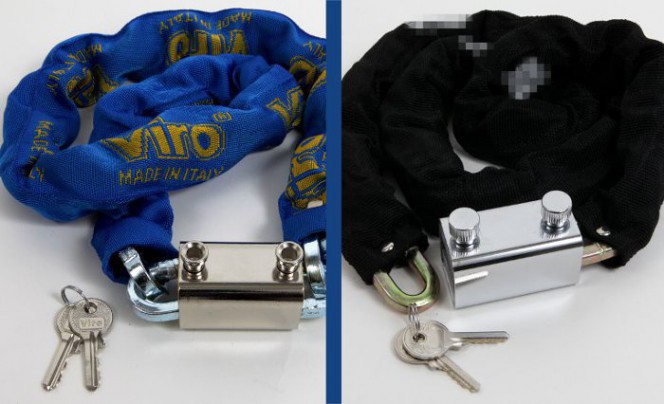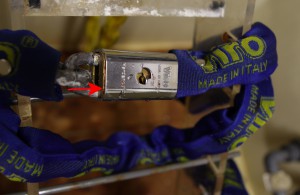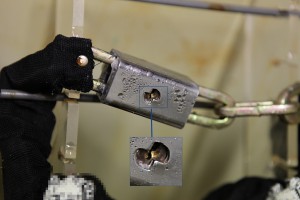After a few weeks break let’s look again at Padlocks & Chains. This blog will show photos and videos of experiments performed in the laboratory to test the strength of original Viro products and the copies imported from the Far East. This week we will examine the Viro “Blocca Catena”, comparing it with an imitation.
Salt spray test
As we saw in previous blogs, the first test to which we usually submit the two products, a Viro original and an imitation imported from the Far East, is that of resistance to oxidation.
“An example of the corrosion test is the salt spray chamber: it is an apparatus in which the material to be tested is subjected to an environment with a high salt concentration; in this way you can simulate the behaviour of the material in marine environments” (Wikipedia).
As can be seen, the only point that shows some small signs of oxidation in the “Blocca catena” is the edge of the anti-drill plate. This effect is not linked to the resistance of the product; in fact, the outer armour and, above all, the internal mechanism, are free from corrosion.
In the copy, on the other hand, there are many corrosion points; in particular, it is possible to see an oxidisation deposit in the area in which the key is inserted. The quantity may not seem very significant, but it is a sign of a much more serious corrosion of the internal mechanism.
This is shown in the following video, where you can clearly see the differences between the two products after the test.
Whilst the original Viro product still works perfectly, the copy is blocked; it is extremely difficult to insert the key and it will not turn.
What has made the Viro product more resistant?
What has contributed during the test to keep the Blocca catena nearly flawless, after 40 hours of salt spray, which corresponds to about a year of real-life environment subjected to harsh weather conditions, are the chemical treatments (copper, nickel and chrome plating) to which it has been subjected, to ensure a greater resistance over time, even when exposed to severe climatic conditions.
On the contrary, after the same 40 hours of salt spray testing, the armour of the imitation padlock was considerably damaged and oxidised in many points. And above all, the internal mechanism is completely oxidised and no longer allows the opening of the padlock with its key. This is a clear symptom of poor corrosion resistance, due to very poor and limited chemical treatments.
Another difference which catches the eye is the different colour of the two products. In fact, the original Viro padlock has a smooth and shiny chrome-plated “mirror” finish on the surface of the steel armour, whilst the copy has an opaque chrome-plated satin finish.
This is not just a purely aesthetic difference. Indeed, only a perfectly precise and constant machining of the materials provides a “mirror” surface finish, whilst, when you want to “disguise” production inconsistencies and imperfections of machined surfaces, or of the materials themselves, it is necessary to resort to a satin surface finish which makes everything less defined.
In the upcoming blogs we will present the results of tests for withstanding cutting and blows. Stay tuned!




I like the report